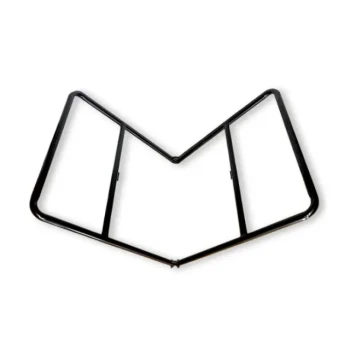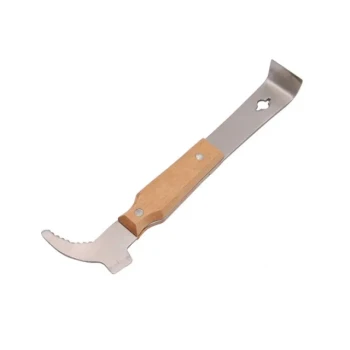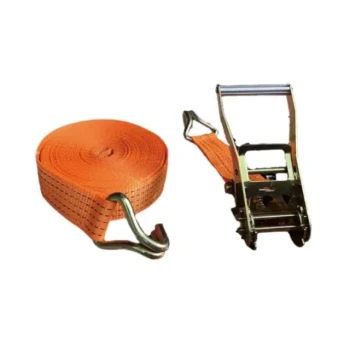To move bees from a Langstroth to a top bar hive, your two primary options are a "cut-down" transfer or a "shakedown." A cut-down involves carefully cutting the comb out of the Langstroth frames and attaching it to the top bars, preserving the existing brood. A shakedown is simpler, involving shaking all the bees into the new hive and forcing them to build entirely new comb from scratch.
The core challenge is not just moving the bees, but managing the colony's transition from a highly structured, framed environment to a free-form one. Your success depends on preserving the brood if possible and providing immediate, consistent resources to help the colony rebuild.
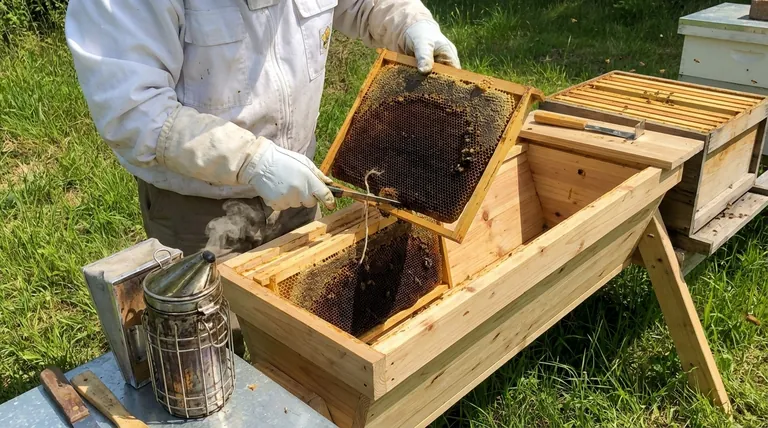
Preparing for the Transfer
A successful transfer is a well-planned one. Setting up your equipment and choosing the right time will dramatically reduce stress on both you and the bees.
Set Up Your Top Bar Hive
Before you begin, prepare the new hive. Remove 5-6 bars from one end to create an open space. Place a divider board (also called a false back) to confine the bees to a smaller, more manageable area. Finally, install a feeder and reduce the entrance to its smallest opening to help the colony defend its new home.
Choose the Right Time
Perform the transfer on a warm, calm day, preferably during a nectar flow. Good weather minimizes chilling of the brood, and the availability of natural forage reduces the colony's stress. Avoid windy or rainy conditions.
Gather Your Equipment
You will need your smoker, a hive tool, a bee brush, and a sharp knife. For the cut-down method, you will also need zip ties or cotton string to attach the old comb to the new top bars. A spray bottle with 1:1 sugar water can help calm the bees.
Method 1: The Cut-Down Transfer (Preserving Brood)
This method is more labor-intensive but gives the colony a significant head start by preserving their brood, honey, and pollen stores.
Step 1: Find and Secure the Queen
Carefully inspect your Langstroth frames to locate the queen. Once found, gently coax her into a queen clip or cage to ensure she is not harmed during the transfer and ends up safely in the new hive.
Step 2: Cut Comb from the Langstroth Frame
Take a frame of brood comb and lay it flat. Use your knife to cut the comb away from the four sides of the wooden frame. You are aiming to free the entire sheet of comb.
Step 3: Attach Comb to the Top Bars
Place an empty top bar on the sheet of comb. Cut the comb to match the angled sides of your top bar hive, using the hive's divider board as a template. Secure the comb to the top bar using zip ties or by wrapping it with string. The bees will eventually chew away the string or incorporate the ties into new wax.
Step 4: Arrange Bars in the New Hive
Place the newly attached combs into the center of the top bar hive. Put the queen (still in her cage) between two central frames of brood. Fill the remaining space with any honey-filled combs you transferred and empty top bars. Release the queen after 24 hours.
Method 2: The Shakedown Transfer (A Fresh Start)
This method is faster and ensures the bees build all-new, clean comb. It is essentially like installing a package of bees.
Step 1: Place the Queen in the New Hive
Find the queen in the Langstroth hive and place her in the top bar hive. This ensures the rest of the colony will follow and stay.
Step 2: Shake the Bees
Hold each Langstroth frame over the open top bar hive and give it a firm, sharp shake. Most of the bees will fall directly into their new home. Use a bee brush to gently sweep off any remaining bees.
Step 3: Close the Hive
Once the majority of bees are in the new hive, replace the top bars and close the lid. The bees from the old hive will orient to the queen's pheromones and join the rest of the colony in the new hive.
Understanding the Trade-offs
Moving to a top bar hive represents a fundamental shift in beekeeping philosophy and management.
Management Style
Langstroth hives are designed for active, hands-on management. Inspections involve pulling and checking individual frames for health, space, and productivity.
Top bar hives encourage a less invasive, "bee-centric" approach. Inspections are often quicker, as you only lift one bar at a time, disturbing a smaller portion of the colony.
Hive Expansion and Flexibility
The Langstroth system is modular. You expand the hive vertically by adding boxes (supers), making it ideal for large-scale honey production and splitting fast-growing colonies.
Top bar hives expand horizontally. As the colony grows, you simply move the divider board down and add more empty bars. This creates a finite limit to the hive's size.
Comb Integrity
Langstroth frames, often with foundation, create robust and durable combs that can be spun in an extractor and withstand transportation.
Top bar combs are attached only at the top and are therefore much more fragile. They cannot be extracted and are not well-suited for moving hives frequently.
Post-Transfer Critical Care
The 2-3 weeks following the transfer are the most critical for the colony's survival.
The Importance of Continuous Feeding
Whether you perform a cut-down or a shakedown, you must feed the colony continuously with a 1:1 sugar water solution. The bees need an immense amount of energy to draw new comb, attach old comb, and establish their new nest. Do not stop feeding until they have drawn out several new combs.
Monitor for Acceptance
After a few quiet days, perform a very brief check. Look for signs that the queen has been accepted and is laying eggs in new cells. In a cut-down, check that the bees are starting to attach the transferred comb to the sides of the hive.
Minimize Early Inspections
Resist the urge to perform full, disruptive inspections. The newly built or newly attached comb is extremely fragile. Give the colony a few weeks to solidify their new home before resuming regular checks.
Making the Right Choice for Your Goal
Your reason for switching hive types should guide which transfer method you choose.
- If your primary focus is preserving your colony's strength: Use the cut-down method to transfer existing brood, giving the colony a significant head start on population growth.
- If your primary focus is disease prevention or starting with clean comb: Use the shakedown method to force a complete rebuild, breaking the brood cycle and ensuring all new wax.
- If you want the best chance of success: The cut-down transfer, while more work, is generally less stressful on the colony and increases the odds of survival.
Ultimately, a successful transfer hinges on careful planning, minimizing stress on the bees, and providing the resources they need to thrive in their new home.
Summary Table:
| Method | Key Action | Best For |
|---|---|---|
| Cut-Down Transfer | Cutting comb from frames & attaching to top bars | Preserving colony strength, brood, and honey stores |
| Shakedown Transfer | Shaking bees into the new hive | Disease prevention, starting with clean, new comb |
Ready to equip your apiary for a successful hive transfer? HONESTBEE supplies commercial apiaries and beekeeping equipment distributors with the durable, wholesale-focused supplies needed for any beekeeping operation. From top bars and hive tools to feeders and protective gear, we provide the reliable equipment that supports beekeepers through transitions and beyond. Contact our team today to discuss your wholesale needs and ensure your colonies have the best foundation.
Visual Guide
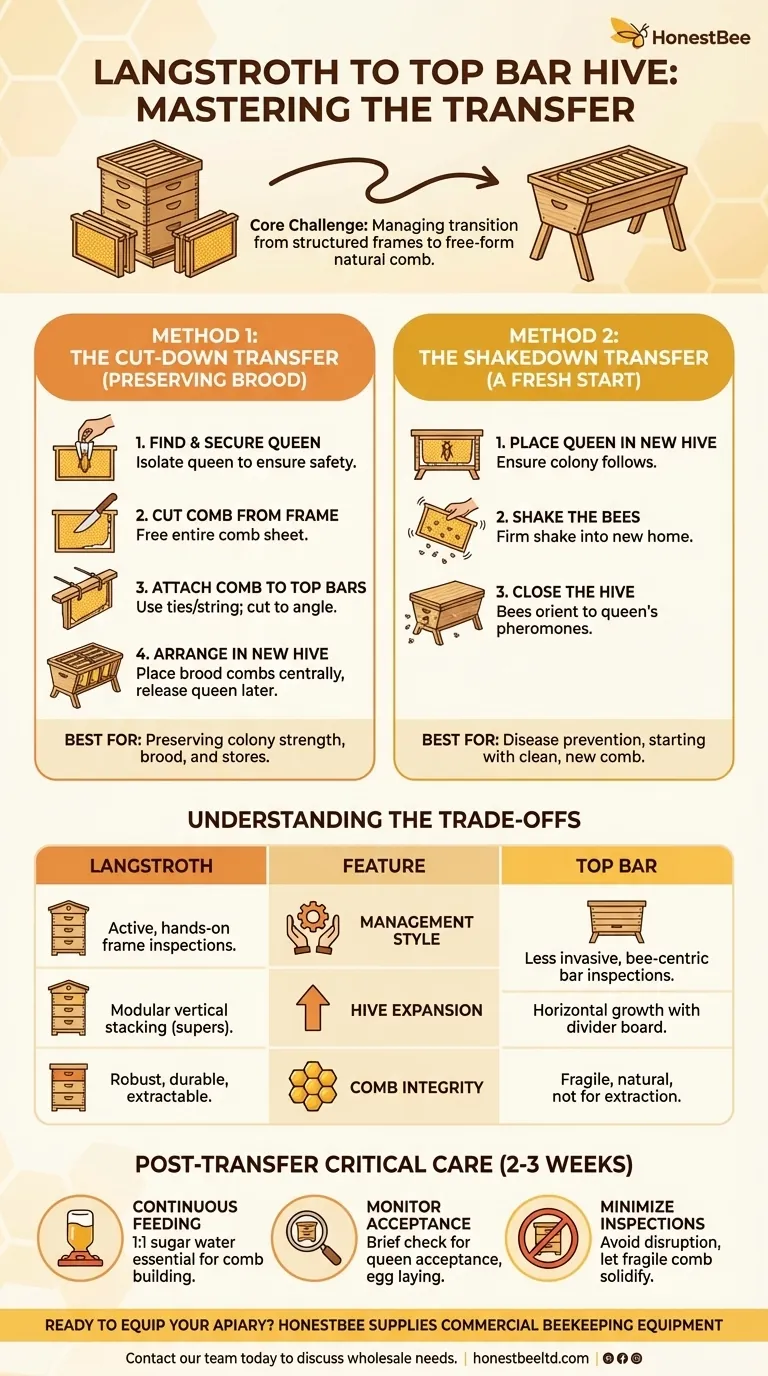
Related Products
- Top Bar Beehive for Beekeeping Wholesales Kenya Top Bar Hive
- Long Langstroth Style Horizontal Top Bar Hive for Wholesale
- Ergonomic Two Person Foldable Hive Lifter
- HONESTBEE Professional Multi-Functional Hive Tool with Ergonomic Wood Handle
- HONESTBEE Advanced Ergonomic Stainless Steel Hive Tool for Beekeeping
People Also Ask
- Why are hive inspections easier with Top Bar Hives? Achieve a Calmer, Safer Approach to Beekeeping
- Which is better Kenya top bar hive or Langstroth? Choose the Right Hive for Your Goals
- What is the quickest method to harvest honey from a top bar hive? A Guide to the Simple 'Cut and Crush' Method
- What are the key features of the Kenyan Top Bar Hive? A Guide to Simpler, Natural Beekeeping
- What are the benefits of a top bar hive? A Natural, Low-Impact Approach to Beekeeping


